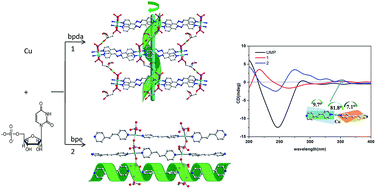Unusual crystal structure and chirality of uridine 5′-monophosphate coordination polymer†
Abstract
Two types of Cu(II)–UMP-L coordination polymers, {[Cu2(UMP)2(bpda)2(H2O)3]·10H2O}n (1) and {[Cu2(UMP)2(bpe)2(H2O)2]·7H2O}n (2) (UMP = uridine 5′-monophosphate, bpda = 1,4-bis(4-pyridyl)-2,3-diaza-1,3-butadiene, bpe = 1,2-bis(4-pyridyl)ethylene), were designed and synthesized for researching the effect of auxiliary ligand. X-ray single-crystal diffraction analysis revealed that complex 1 is the first example of a 1D parallel double-bridged coordination polymer in a nucleotide–metal coordination complex, while complex 2 is a 2D grid coordination polymer. Based on their crystal structure analysis, their chirality, including molecular chirality, supramolecular helical chirality and auxiliary ligand's extended axial chirality (EAC), was studied by aqueous solution and solid state circular dichroism (CD) spectroscopy. The length and conjugated auxiliary ligand had an influence on the EAC.



 Please wait while we load your content...
Please wait while we load your content...